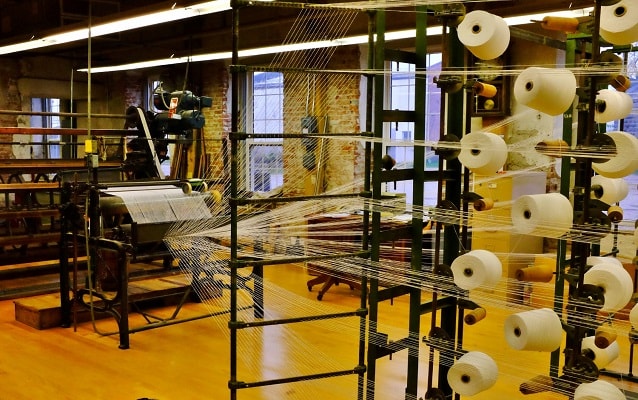Last updated: December 18, 2017
Place
Amana Woolen Mill

Photo by Neal Wellons (Flickr)
Construction of the Woolen Mill in Amana began in 1859, and the complex was continually expanded until 1943. A salesroom was later added in the 1960s. It was one of two mills in the Colonies.
Amana's first settlers brought their looms in crates from Germany. The practice of selling woolen blankets, suiting and fabric began in 1838, when the Inspirationists lived at the Arnsburg Estate in Germany. The Amana Woolen Mill was originally water-powered, generated from the seven-mile Mill Race. Eventually this source was replaced by steam, and then by electricity, including water powered generators. The impact of the sprawling complex of buildings that makes up the Woolen Mill reached far beyond its walls. The sound of the machines could be heard throughout the village of Amana and is remembered fondly by the local residents. Profits from the mill have supported the community throughout its history.
By 1890 the woolen mills produced 3,000 yards of woolen goods daily, which required over a half million pounds of wool annually. Although the Amana Society had over 3,000 sheep, wool still had to be imported from Texas, Colorado, and sometimes Australia. Amana Society members acted as agents for the mills, traveling to Maine and the Pacific to sell their goods. Perkins and Wick, in their book History of the Amana Society or Community of True Inspiration, described the mills: "There is no 'piece work' method here, for everything is done well, without the rush and hurry which we see in other factories. Their goods are the best in the market, and the following expression is often heard; 'Colony goods, full width, a yard wide'."
The wool moved through the carding, dyeing, weaving, and finishing departments and then into the storage building. Disaster struck the carding house in 1923, when a fire which began at a flour mill spread to the Woolen Mill complex. The carding house was repaired, but the third floor was not replaced. In 1943 a third floor was added to the weaving house, but this was later blown off during a severe windstorm in June 1998. Like the carding house in 1923, the Amana Society did not replace it, but rebuilt the second floor. Nationally, the woolen industry has borrowed a lot from the Amana Colonies. Amana weavers perfected machinery design, later sharing these improvements with other American mills with no patent or royalty asked.
